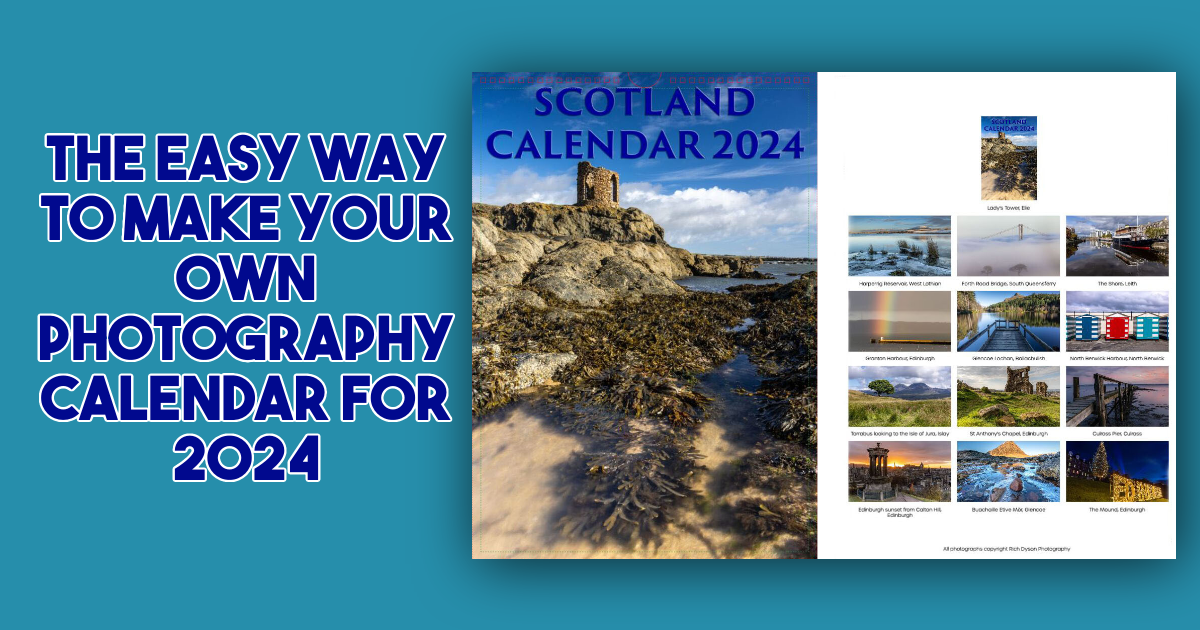September 27, 2023
Making of Calendar 2024
From shooting to printing, the end-to-end process of preparing the 2024 Rich Dyson Photography Scotland Calendar

Every year, I produce a calendar of landscape photographs of Scotland. It’s an excellent gift for my clients and an income earner for me, selling through my website. If you’re interested in making a calendar, it doesn’t have to be time-consuming; the key is planning ahead.
Selecting your photos
When creating my calendar, I have two criteria when deciding on the photos that will be included. First, I want the pictures to be my most current work. Secondly, they need to be good enough photos for me to want to include them. There’s an easy way to do this (as long as you take photos you think are good enough!).
As my photos are imported into Adobe Lightroom, I decide at this point if a photo has the potential to be in the following year’s calendar. If it is, then I use one of the myriad of markers available in Lightroom. For me, I set a colour label to green by pressing the eight key. You don’t need to use this marker, but whatever you choose, make sure it isn’t being used to categorise any other images. Every photograph can have one of three markers applied to it: Ratings of 1 to 5, Five colour markers, and a flag indicator
Viewing your best photos
Now that you’ve identified your best photos, there is an easy way to combine them to choose your best 12 or 13 images to make the final calendar. Smart Collections are a simple way to bring together photographs that share common criteria.
I start by creating a Collection Set. Click on the ‘+’ sign at the top of the Collections Panel and select ‘Create Collection Set’. Give it a name, say Calendar 2024, then press the Create button.

Next, select the newly created Collection Set and either press the same ‘+’ sign or right-click the set and take the option ‘Create Smart Collection’. Within this screen, you can build the criteria to select your potential calendar images. There are many criteria that you can search on to select your photos. You can add multiple criteria by clicking on the ‘+’ sign at the end of each criteria line. My Smart Collection looks for photos taken between two dates with a Colour label set to Green.

If you set the Smart Collection up at the start of the year, you’ll automatically see your calendar-worthy photos added to the collection.
Choosing your best photos
When it comes to the time when you’re creating your calendar, it will be very much up to you to decide which photos make the cut. I’m lucky that I think my wife has a ‘good eye’ for which photos will work best. We put an hour aside to look at the images in the Smart Collection and start deciding which works best together. I like to choose images that are representative of the month the calendar is showing. You can use the filter in the library module to choose images only taken during a specific period. If you can’t see the filter at the top of the screen, press the ‘\’ key, and it will toggle on.

I created a normal Collection inside the Collection Set for my final selection. I then drag the photos for the final selection into this collection. The benefit is that you can re-order photos inside a collection, allowing you to see visually how the images will flow throughout the year.
Printing your calendar
The final step is printing your calendar. The choice here depends on the number of calendars you want to print, the quality you want to print at, and most importantly, your budget. Home printing is usually expensive, and you’ll probably not have the equipment to bind the pages together.
Single print runs are usually best through one of the bigger names, such as Photobox or Bonus Print. However, the downside of these printers is that they can often have limited designs and customisation options. For a single calendar, you can usually expect to pay around £15 for it to be printed, and shipping costs may be added.
If you print multiple calendars, it is usually best to look at specialist suppliers. They usually have higher prices for single print runs, but their prices can drop quite significantly as the volume increases. For the last four or five years, I have used Colour Calendars. They offer a choice of design templates that can be printed on various paper thicknesses and in different finishes. You can also create the calendar yourself and send PDFs to them for them to print. If you are interested in using Colour Calendars, you can use a referral code of REF5%RICHDYSON to receive 5% off your order.

This year’s Scotland 2024 calendar looks brilliant. I’m delighted with the quality that Colour Calendars delivers, and I’m sure that my regular customers will love it when their calendar drops through their letterbox. If you’d like to buy the 2024 Scotland calendar, it’s available for £11.99 plus £3 shipping in the UK or £9 worldwide. If you live in the Edinburgh area, you can pick up the calendar without any postage fees. Order today for immediate delivery at https://richdysonphotography.com/shop/p/2024-calendar
Please give us your feedback.
If you’ve got any questions or comments, leave them below. You can sign up for the Edinburgh Photography Workshop monthly newsletter, where you’ll get regular updates on exciting things happening in photography and some great tips. Sign up by clicking here.
About the author
As well as running Edinburgh Photography Workshop, Rich Dyson is a professional photographer. His photographs are regularly used in newspapers such as The Times, Guardian and Daily Telegraph. He also had two solo exhibitions and was featured in a members-sponsored exhibition in the Scottish Parliament. You can see and buy his photography at richdysonphotography.com.